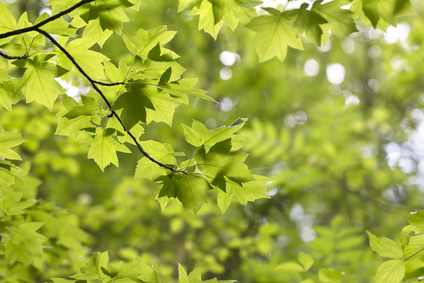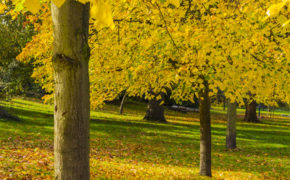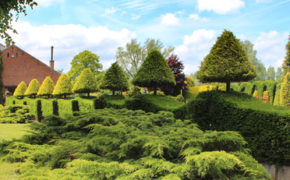
Get a quick no obligation quote It’s free and will only take a jiffy!
When Should I Prune my Wild Service Tree?
When is the best time to prune a wild service tree? Why is wild service tree pruning important? What are the most common wild service tree diseases? Discover the answers to all these questions by reading on…
The wild service tree, otherwise known as Sorbus torminalis, is a UK native broadleaf deciduous tree that is also common across parts of Europe, Africa and Asia. A mature service tree will often reach heights of 25 metres and is identified by its broad, pinnately lobed leaves that transform into a stunning red-brown hue in autumn. It is also defined by its cream coloured summer flowers and small brown fruits which need to be decomposed through freezing before they can be edible. These fruits are often used to flavour alcoholic drinks such as whisky.
Although fairly rare, the service tree will usually be found in ash and oak woods as well as ancient woodland. It favours lime and clay based soils.
Why prune a wild service tree?
The service tree rarely needs pruning aside from keeping it healthy and safe so that it does not pose a hazard to people or property.
Sometimes the service tree will produce shoots that become congested or don’t grow in the right direction, making the tree appear unruly. Pruning will relieve these issues and will help boost air flow and light penetration, all good for the tree’s health.
When is the best time for wild service tree pruning?
The best time to prune a service tree is during late winter to early spring outside of the growing season so that the wounds do not produce sap, which can attract insects and therefore disease. Your aim is to tidy up the tree and keep it safe and healthy which involves light pruning only; hard pruning is not recommended for this tree.
If at any point during the year you discover diseased or damaged branches in your service tree that could be posing a hazard, then you should go ahead and remove them as soon as you can.
What to look for when pruning a wild service tree
It is important to look out for common diseases when pruning any tree, and the service tree will often present symptoms of silver leaf disease, fireblight, bacterial canker, bracket fungi, coral spot and Verticillium wilt.
Silver leaf disease affects the wood and leaves of various trees. It gets in through wounds and leads to a silvering of the leaves followed by death of the branch.
Fireblight is a bacterial disease affecting the fruits of trees, leading to the appearance of having been scorched by fire.
Bacterial canker will show itself as sunken patches of dead bark and small holes in leaves, called ‘shothole’.
Bracket fungi leads to decay and rot in the heartwood of trees and causes bracket-shaped fruiting bodies on the trunk or main branches. The fungi will usually weaken the tree and sometimes the trees will break or fall completely.
Coral spot is a fungal disease. It causes branches to die back and you will see small, coral-pink raised spots appearing after the branch dies. If you detect coral spot then this usually means the tree has been weakened due to other factors.
Verticillium wilt is a soil-borne fungal disease that gets into trees through the roots. It leads to dieback and leaf wilting.
Tree Preservation Orders
It is forbidden to proceed with any sort of tree work if there is a Tree Preservation Order (TPO) in force. Check this before you go ahead and where it is required, you’ll need to apply to the local authority for permission to undertake work on the tree which can take up to eight weeks to come through. Also be aware that if the tree is sited in a conservation area, permission must be obtained before undertaking works of any kind.
The importance of wild service tree pruning expertise
The only way you can be absolutely certain that your service tree is receiving the attention it needs and deserves is to engage the professional assistance of a qualified tree surgeon. With their extensive knowledge of all species of tree, they will be completely aware of the most appropriate time and processes to use to prune your wild service tree. They’ll also have the knowledge required to spot diseases and provide the right advice on treatments to deal with them.
When you are choosing a tree surgeon, always ensure you ask for checkable references and certificates that prove their qualifications. Also ask to see their insurance documents for total peace of mind that you are covered for the work you are paying for. In addition, where possible, do whatever you can to engage a tree surgeon with Trading Standards and local authority approval.
If you have a wild service tree that needs pruning or other attention, why not get in touch with T.H. Tree Surgery Services? As fully qualified and highly experienced Trading Standards and local authority approved tree surgeons, we can provide specialist expertise across all aspects of service tree pruning. For a free, no-obligation quotation, contact our helpful experts on 01268 642814 or get in touch here.
Amazing service from Mark and his team. We had a problem with Bamboo that had spread from a neighbours garden. Mark kept us informed with regular phone calls and images of how the work was progressing, as we were not present the house. 1st class job and a pleasure to do business with this company.
Thank you Colin and Gillian for your kind review. It was a pleasure to be able to clear the bamboo for you.








